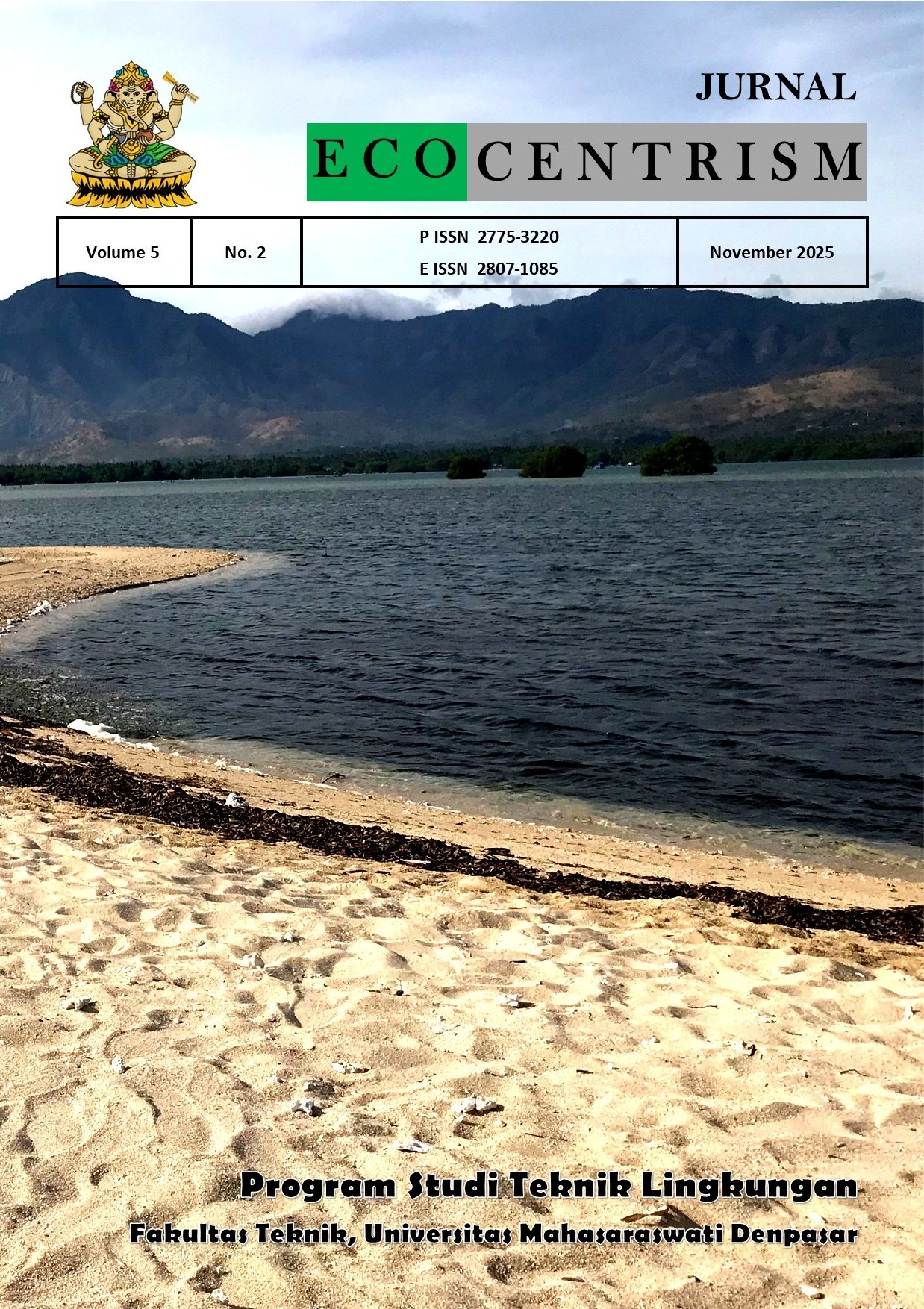IMPLEMENTASI SAFE WORK PRACTICE (SWP) DAN HIRARCH DALAM PENGELOLAAN LIMBAH B3
DOI:
https://doi.org/10.36733/jeco.v5i2.12913Keywords:
Hazardous waste, HIRARC, Occupational safety, Environmental management, Safe Work PracticeAbstract
Industrial and operational activities in various sectors, such as manufacturing, oil, gas, mining, and healthcare, have the potential to generate hazardous and toxic waste (B3) that can contaminate the environment, endanger human health, and threaten occupational safety. The management of B3 waste, which includes collection, storage, transportation, and final processing, carries a high risk of accidents and exposure to hazardous materials. These risks are generally due to workers' lack of knowledge of safe work procedures, improper use of personal protective equipment (PPE), and the failure to implement optimal occupational safety standards. The purpose of this study was to analyze the effectiveness of Safe Work Practices (SWPs) using the Hazard Identification, Risk Assessment, and Risk Control (HIRAC) approach at each stage of B3 waste management, from generation, packaging, and storage to transportation. The methods used included field observation, data collection from company documents, and risk analysis based on probability and severity matrices. The study results indicate that the implementation of SWPs has been generally effective, characterized by a predominantly low to moderate risk level. Therefore, the implementation of SWPs plays an important role in minimizing potential hazards in B3 waste management, but it is necessary to strengthen operational discipline and optimize supporting facilities to improve occupational safety performance.
References
Ajslev, J. Z. N., Møller, J. L., Andersen, M. F., Pirzadeh, P., & Lingard, H. (2022). The Hierarchy of Controls as an Approach to Visualize the Impact of Occupational Safety and Health Coordination. International Journal of Environmental Research and Public Health, 19 (5), 2731. https://doi.org/10.3390/ijerph19052731.
Anna Mazzi. (2023). Environmental and safety risk assessment for sustainable circular production: Case study in plastic processing for fashion products. Heliyon, Volume 9, Issue 11, e21352, ISSN 2405-8440, https://doi.org/10.1016/j.heliyon.2023.e21352.
Chao Chen, Jiali Tang, Jie Li, Genserik Reniers, Changjun Li. (2025). A systematic review of safety risk assessment research in China. Journal of Safety Science and Resilience, Volume 6, Issue 1, Pages 58-69,ISSN 2666-4496, https://doi.org/10.1016/j.jnlssr.2024.06.012.
Gusri, L., Manab, A., Permana, E., Saputra, A., Arifin, A. P., & Santoso, A. (2024). Identifikasi Bahaya dan Penilaian Risiko (HIRA) Terhadap Juru Las di Bengkel Las CV. X, Kota Jambi: Hazard Identification and Risk Assessment (HIRA) of Welders in the Welding Workshop at CV. X, Jambi City. Jurnal Teknologi Lingkungan, 2(2), 69–78. DOI: https://doi.org/10.29408/jtl.v2i2.27981.
International Labour Organization. 2019. Safety and health at the heart of the future of work: Building on 100 years of experience. Geneva: ILO. https://www.ilo.org/sites/default/files/wcmsp5/groups/public/@dgreports/@dcomm/documents/publication/wcms_686645.pdf. Diakses pada tanggal 27 Oktober 2025.
Lumansik, E. P., Riogilang, H., & Riogilang, H. (2024). Analisis Risiko Dan Optimasi Pengelolaan Limbah B3 Dengan Metode HIRARC (Hazard Identification, Risk Assessment, And Risk Control) Di RSUD Anugerah Tomohon. TEKNO, 22(87), 463–477. https://ejournal.unsrat.ac.id/v3/index.php/tekno/article/view/54722
National Institute for Occupational Safety and Health. 2015. Hierarchy of controls. U.S. Department of Health and Human Services, Centers for Disease Control and Prevention. https://www.cdc.gov/niosh/topics/hierarchy/default.html. Diakses pada tanggal 27 Oktober 2025.
Occupational Safety and Health Administration. 2020. Recommended practices for safety and health programs. U.S. Department of Labor. https://www.osha.gov/safety-management. Diakses pada tanggal 27 Oktober 2025.
Oetoyo, B. W., & Widiawan, K. (2022). Hazard Identification, Risk Assessment, Risk Control (HIRARC) pada PT Jindal Stainless Indonesia. Jurnal Titra, 10(2). https://publication.petra.ac.id/index.php/teknik-industri/article/view/12997.
Ovinuchi Ejiohuo, Helen Onyeaka, Adenike Akinsemolu, Ozioma Forstinus Nwabor, Kehinde Favour Siyanbola, Phemelo Tamasiga, Zainab T. Al-Sharify. (2025). Ensuring water purity: Mitigating environmental risks and safeguarding human health. Water Biology and Security, Volume 4, Issue 2, 100341, ISSN 2772-7351. https://doi.org/10.1016/j.watbs.2024.100341.
Pascarella G, Rossi M, Montella E, Capasso A, De Feo G, Botti G, Nardone A, Montuori P, Triassi M, D'Auria S, Morabito A. (2021). Risk Analysis in Healthcare Organizations: Methodological Framework and Critical Variables. Risk Manag Healthc Policy. Jul 8;14:2897-2911. doi:10.2147/RMHP.S309098.
Peraturan Menteri Kesehatan Republik Indonesia. 2019. Peraturan Menteri Kesehatan Nomor 25 Tahun 2019 tentang Penerapan Manajemen Risiko Terintegrasi di Lingkungan Kementerian Kesehatan. https://peraturan.bpk.go.id/Details/138619/permenkes-no-25-tahun-2019. Diakses pada tanggal 27 Oktober 2025.
Peraturan Menteri Lingkungan Hidup Dan Kehutanan Republik Indonesia .2021. Peraturan Menteri Lingkungan Hidup Dan Kehutanan Republik Indonesia Nomor 6 Tahun 2021 Tentang Tata Cara Dan Persyaratan Pengelolaan Limbah Bahan Berbahaya dan Beracun. https://jdih.menlhk.go.id/new2/uploads/files/2021pmlhk006_menlhk_06082021104752.pdf. Diakses pada tanggal 27 Oktober 2025.
Peraturan Pemerintah Republik Indonesia 2021. Peraturan Pemerintah Republik Indonesia Nomor 22 Tahun 2021 Tentang Penyelenggaraan Perlindungan Dan Pengelolaan Lingkungan Hidup. https://peraturan.go.id/id/pp-no-22-tahun-2021. Diakses pada tanggal 27 Oktober 2025.
Ran Liu, Hu-Chen Liu, Hua Shi, Xiuzhu Gu. (2023). Occupational health and safety risk assessment: A systematic literature review of models, methods, and applications. Safety Science, Volume 160, 106050, ISSN 0925-7535, https://doi.org/10.1016/j.ssci.2022.106050.
Rout BK, Sikdar BK (2017). Hazard Identification, Risk Assessment, and Control Measures as an Effective Tool of Occupational Health Assessment of Hazardous Process in an Iron Ore Pelletizing Industry. Indian J Occup Environ Med. May-Aug;21(2):56-76. doi:10.4103/ijoem.IJOEM_19_16. PMID: 29540967; PMCID: PMC5844132.
Siddiqua A, Hahladakis JN, Al-Attiya WAKA. (2022). An overview of the environmental pollution and health effects associated with waste landfilling and open dumping. Environ Sci Pollut Res Int. Aug;29(39):58514-58536. doi:10.1007/s11356-022-21578-z. Epub 2022 Jul 1. PMID: 35778661; PMCID: PMC9399006.
Todd ECD, Faour-Klingbeil D. (2024). Impact of Food Waste on Society, Specifically at Retail and Foodservice Levels in Developed and Developing Countries. Foods. Jul 1;13(13):2098. https://doi.org/10.3390/foods13132098.
Wilson Lee Wui Siang, Mohd Rafee bin Baharudin, Anita binti Abdul Rahman, Nor Halim bin Hasan. (2025). Effectiveness of HIRARC in OSH Risk Management. medRxiv.2025.06.11.25329443; doi:https://doi.org/10.1101/2025.06.11.25329443


